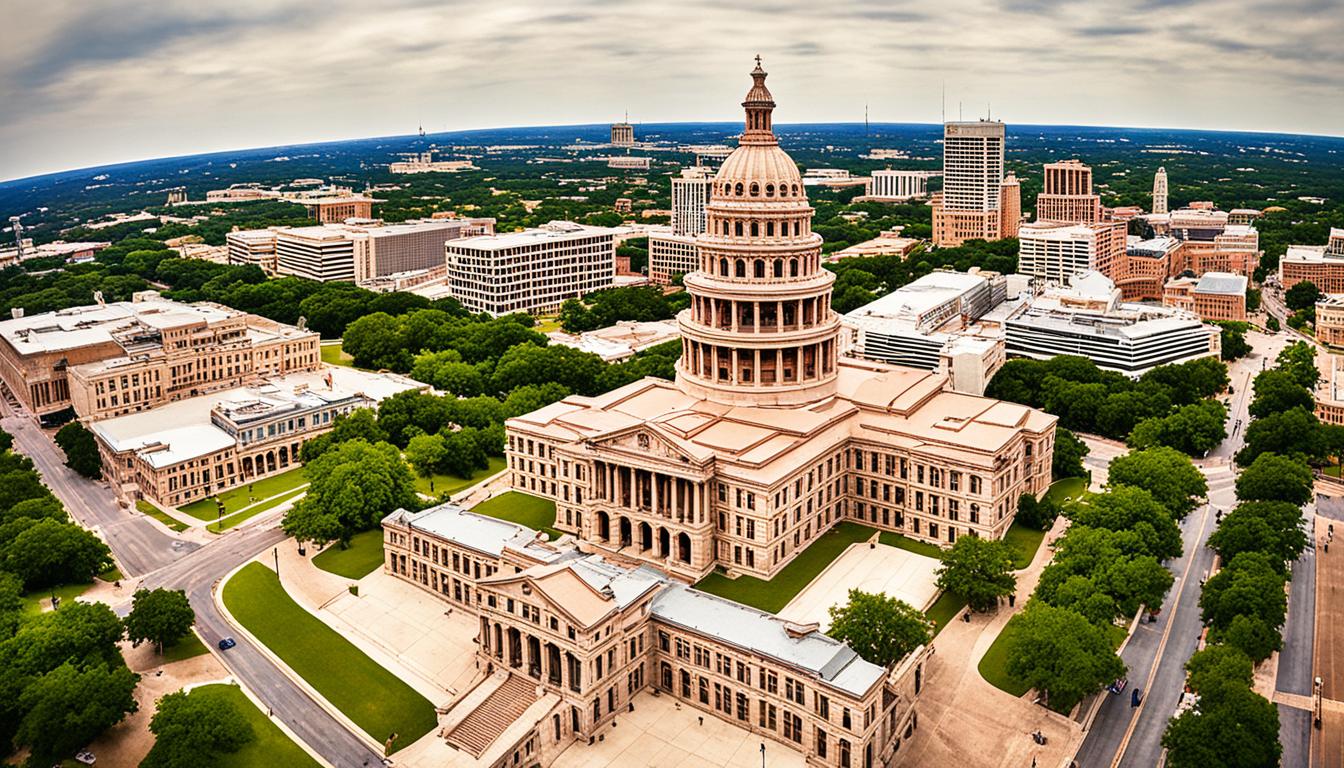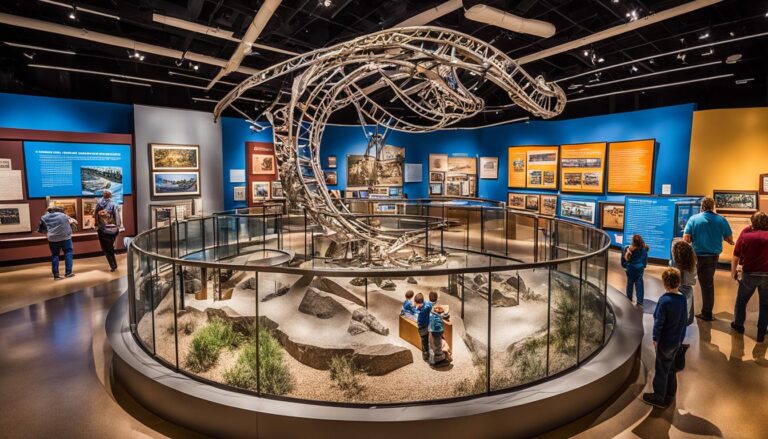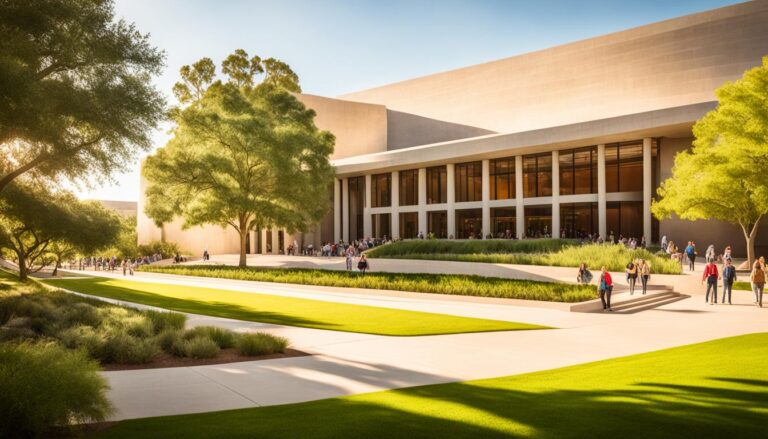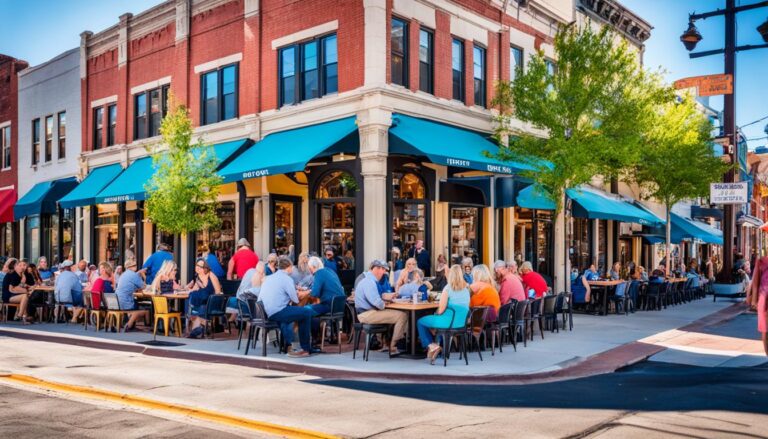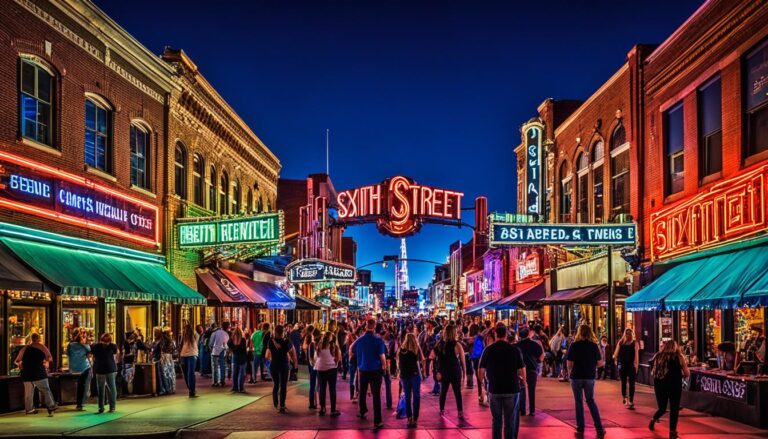Texas State Capitol: History and Tours
Did you know the Texas State Capitol tours have a high rating of 4.7 out of 5? This score comes from 937 votes. This famous spot in Austin is not just important for its history. It’s a must-see for people who love buildings. Tours happen six days a week at different times. With tickets at $20, exploring the State Capitol’s rich history is easy. The Capitol’s design from the late 1800s stands out. It’s made from “sunset red” granite. This makes it a top example of state capitol buildings in the country.
Built in 1888, the Texas State Capitol won a national design contest. Its Renaissance Revival style makes it special. Free tours start from the South Foyer outside room 1S.2. These 30-minute tours are very interesting. They show off the building’s design, Texas history, and legislative process. Capitol Accessibility Services makes sure everyone can join in. The Capitol grounds have been beautifully updated. An $8 million project now offers amazing views toward the Colorado River.
Key Takeaways
- The Texas State Capitol tours have a 4.7 rating out of 937 votes.
- Tours are available six days a week at various times for $20.
- The Capitol’s architecture is a prime example of late 19th-century public architecture.
- Constructed from “sunset red” granite, the Capitol was completed in 1888.
- The surrounding Capitol grounds underwent an $8 million renovation in 1997.
Introduction to the Texas State Capitol
The Texas State Capitol in Austin is more than just a sight to behold. Towering at 302.64 feet, it’s taller than the U.S. Capitol by 14.64 feet. With 392 rooms, 18 vaults, and over a thousand ways to step in or see out, it’s massive. Built over almost seven years, it was finished on December 8, 1888. It’s a key part of the city’s story.
Its stunning exterior is made of red granite from Burnet County. Inside, you’ll find Texas limestone and over 85,000 square feet of copper roofing. The Capitol is connected by tunnels to an Extension added in 1993. This part includes modern spaces like hearing and conference rooms, an auditorium, and even a cafeteria.
Set on 51.4 acres, the Capitol overlooks Austin from a 22-acre hill. It’s a mix of the past and the present. Efforts to preserve its view are strict, with 30 viewing corridors protected by the state. Its historical significance was recognized in 1970 and again in 1986. Today, it’s a National Historic Landmark.
| Key Features | Details |
|---|---|
| Height | 302.64 feet (92.24 m) |
| Original Construction Cost | $3.7 million |
| Total Square Footage of Underground Extension | 667,000 square feet (62,000 m2) |
| Area | 51.4 acres (20.8 ha) |
| Acreage of Floor Space | 18 acres or 192,374 square feet |
| Ground Coverage | 3 acres |
| Completion Date | December 8, 1888 |
| Number of Rooms | 392 |
| Number of Windows | 924 |
| Number of Doors | 404 |
Visitors will find lots to explore at the Capitol. There are brochures, mobile tours, and exhibits throughout. Exploring the Texas State Capitol Austin can be a journey back in time. It is both a lesson and an inspiration.
Historical Significance of the Texas State Capitol
The Texas State Capitol stands as a pivotal piece of Austin’s history. It’s a historic landmark that tells the story of its creation. Through tours, visitors gain deep insights into Texas’ heritage.
Early History and Construction
Building the Texas State Capitol started in 1882 and finished in 1888. It spans three acres and has about 18 acres of space inside. Its design includes 392 rooms, 18 vaults, 924 windows, and 404 doors.
Over 1,000 workers contributed to building it, funded by the Republic of Texas. They used 3 million acres of land to pay for the construction.
At its dedication in May 1888, more than 20,000 people celebrated. The event had drill teams, military shows, bands, and fireworks.

Architectural Style and Features
The Capitol’s design, chosen through a competition, reflects the Renaissance Revival style. It features “sunset red” granite and interior Texas limestone. Its copper roof covers 85,000 square feet. Standing at 302.64 feet, it’s taller than the U.S. Capitol.
The Goddess of Liberty statue adds to its magnificence. This statue was made from welding 80 zinc pieces together.
Restorations and Additions
The Capitol’s upkeep has kept it a gem. The 1993 extension added modern features like skylights and hearing rooms. The Capitol got a major $98 million renovation. The grounds also saw improvements worth $8 million. These efforts ensure the Capitol remains a key site for tours.
Exploring the Texas State Capitol Grounds
When you visit the Texas State Capitol, you’ll find a lush outdoor area. It’s as engaging as the building itself. Spread over 20 acres in central Austin, the grounds boast over 180 native trees. Monuments and statues narrate Texas’ rich past. Many monuments honor war soldiers and veterans, celebrating Texas’ diverse heritage.
![]()
Notable Monuments and Statues
The first monument, the Heroes of the Alamo, was set up in 1891. The latest, from 2018, honors fallen veterans’ families since the Global War on Terror. There are also the Tejano Monument from 2012 and the African American History Memorial from 2016. These monuments give a deep insight into Texas’ varied history.
Gardens and Landscaping
The Capitol grounds are more than monuments; they also feature beautiful gardens. After an $8 million renovation, these gardens offer tranquility. With manicured lawns and sculptures, they stand as an oasis in Austin’s city life. Exploring the historic tours here, you’ll enjoy both natural beauty and artistry.
The Texas State Capitol stands out as taller than the Federal Capitol by 14 feet. An underground extension in the 1990s expanded its size. This architectural gem also showcases six seals representing the nations that have claimed Texas over time.
| Feature | Details |
|---|---|
| Size | Over 20 acres |
| Native Trees | More than 180 |
| First Monument | Heroes of the Alamo Monument (1891) |
| Most Recent Monument | Honoring Families of Fallen Veterans (2018) |
| Tallest Structure | Texas State Capitol, 14 feet taller than Federal Capitol Building |
As visitors explore, the Capitol grounds reveal Texas’ story. The State Preservation Board keeps this space alive. It ensures the Capitol remains a must-see place for everyone.
Texas State Capitol Austin: A Detailed Look Inside
Walking into the Texas State Capitol in Austin is like stepping back in time. It’s made of pink granite donated for the build. Its outside beauty is matched inside with portraits and items from Texas’ history. Finished in 1888, it sits at 302.64 feet tall, ranking it the sixth-tallest state capitol in America.
Tours are free and happen from 9:30 a.m. to 3:30 p.m. on weekdays. Weekend tours are from 12:30 p.m. to 3:30 p.m. They last around 30 minutes, covering its design, importance, and interesting stories. For independent exploration, grab a pamphlet. Visit the building and its 51.4 acres between 7:00 a.m. and 6:00 p.m. on weekdays, or 9:00 a.m. to 6:00 p.m. on weekends.
About 900 people worked on building the Capitol. This included 86 granite cutters from Scotland. The total cost and donations reached $3.7 million. Its design is not only beautiful but functional, appealing to those into architecture, history, or Texas politics.
In 1993, a $75 million project added 667,000 square feet below ground. This doubled its space and boosted its status as a key landmark.
The Texas State Capitol in Austin is more than a historic site. It’s alive with legislative activities and cultural significance. Explore it through tours or at your own pace. Plus, free parking is available two blocks away. It’s easy for visitors to come see this magnificent building.

